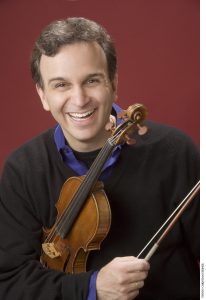David Bruce’s Mystical Violin Concerto

Gil Shaham, violin
photo credit Christian Steiner
No matter how celebrated the composer, a commission is always a gamble. David Bruce’s “Night Parade”— the slightly jazzy, atmospheric tone poem he wrote for the San Diego Symphony’s Carnegie Hall debut and China tour last year—proved amiable, but it was no show-stopper.
His new Violin Concerto “Fragile Light,” which Gil Shaham premiered under Music Director Jahja Ling and the San Diego Symphony Friday (Dec. 12), struck me as a more serious, probing accomplishment, and not simply because it benefitted from Shaham’s meticulous, sympathetic interpretation and iridescent timbre.
From Bruce’s concerto title and his characterizations of each movement—Delicate, shimmering; Misterioso, and Inward, reverential—it will surprise no one that this concerto does not explode with motivic pyrotechnics for the soloist, the typical calling card of the warhorse violin concerto. Instead, Bruce has written an expansive minimalist meditation, giving the solo violin gently arched, floating themes accompanied by delicate, undulating string motifs that create a serene mode of contemplation like the “Homage” sections of Olivier Messiaen’s “Quartet for the End of Time.”
In a few sections, Bruce allowed the soloist and orchestra to pursue more active, robust themes, notably in the middle movement’s giocoso mood, but they invariably returned to contemplation. Overall, I appreciated the subtle complexities of Bruce’s orchestral textures and the manner in which the San Diego Symphony’s soft-edged delineation made them glow. Ling’s attention to detail and care in sustaining the composer’s intentions were of the highest order.
I believe this Violin Concerto has a future, although it will not be a likely vehicle for up-and-coming soloists who want to prove their technical prowess. But for those violinists like Joshua Bell and Shaham whose acclaim is beyond question, Bruce’s “Fragile Light” could prove a welcome antidote to the tedium of repeating the splashy warhorse concertos that are programmed to death.
To complement Bruce’s understatement, for the second half of the program Ling chose Sergei Rachmaninoff’s Symphony No. 2 in E Minor, one of the most melodically opulent and harmonically effulgent of the all the late Romantic symphonies. I am happy to report that unlike the orchestra’s struggle with the Mahler Seventh last month, they played the Rachmaninoff with supreme confidence, a warmly cohesive ensemble, and a sensitive awareness of the composer’s signature melodic expansion. While it was a long journey, 66 minutes by my watch, Ling kept his troops clearly focused and energized throughout. This struck me as some of the finest playing Ling and the orchestra have achieved over the last several years.
Three short orchestral transcriptions of organ chorale preludes by J. S. Bach opened the concert. As an organist, these transcriptions always sound dreamily imprecise, although I understand that turnabout is fair play. In the early decades of the 20th century, civic organists everywhere transcribed reams of orchestral music for the organ, and a lot of it was pretty dreadful. So let me close by admitting that Eugene Ormandy’s arrangement of Bach’s well-known Schuebler Chorale “Wachet Auf, ruft uns die Stimme” (“Sleepers, Awake” in English) was very, very pretty.


